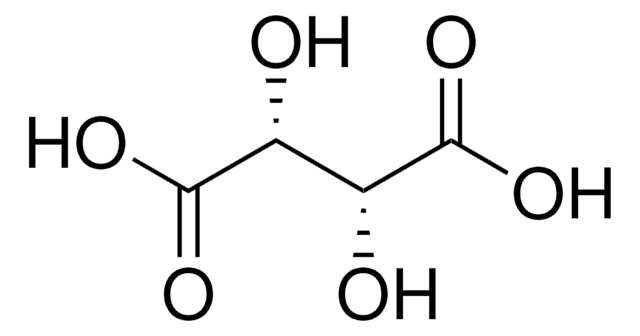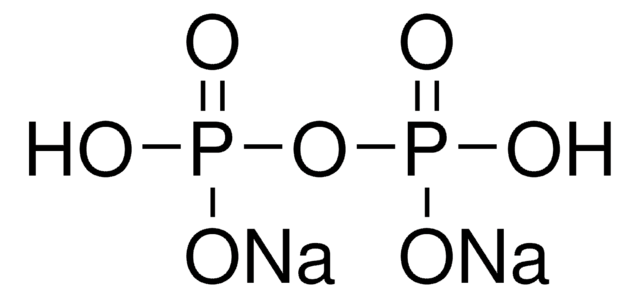Wichtige Dokumente
T109
L-(+)-Tartarsäure
≥99.5%
Synonym(e):
(2R,3R)-(+)-Weinsäure, L-Threarsäure
About This Item
Empfohlene Produkte
Dampfdichte
5.18 (vs air)
Qualitätsniveau
Assay
≥99.5%
Form
granular
powder or crystals
Optische Aktivität
[α]20/D +13.5±0.5°, c = 10% in H2O
Selbstzündungstemp.
797 °F
mp (Schmelzpunkt)
170-172 °C (lit.)
Funktionelle Gruppe
carboxylic acid
hydroxyl
SMILES String
O[C@H]([C@@H](O)C(O)=O)C(O)=O
InChI
1S/C4H6O6/c5-1(3(7)8)2(6)4(9)10/h1-2,5-6H,(H,7,8)(H,9,10)/t1-,2-/m1/s1
InChIKey
FEWJPZIEWOKRBE-JCYAYHJZSA-N
Suchen Sie nach ähnlichen Produkten? Aufrufen Leitfaden zum Produktvergleich
Allgemeine Beschreibung
Anwendung
- A co-former for the synthesis of etravirine co-crystals.
- A mobile phase additive in thin-layer chromatography.
Signalwort
Danger
H-Sätze
P-Sätze
Gefahreneinstufungen
Eye Dam. 1
Lagerklassenschlüssel
11 - Combustible Solids
WGK
WGK 1
Flammpunkt (°F)
302.0 °F - closed cup
Flammpunkt (°C)
150 °C - closed cup
Persönliche Schutzausrüstung
dust mask type N95 (US), Eyeshields, Gloves
Hier finden Sie alle aktuellen Versionen:
Besitzen Sie dieses Produkt bereits?
In der Dokumentenbibliothek finden Sie die Dokumentation zu den Produkten, die Sie kürzlich erworben haben.
Kunden haben sich ebenfalls angesehen
Unser Team von Wissenschaftlern verfügt über Erfahrung in allen Forschungsbereichen einschließlich Life Science, Materialwissenschaften, chemischer Synthese, Chromatographie, Analytik und vielen mehr..
Setzen Sie sich mit dem technischen Dienst in Verbindung.






